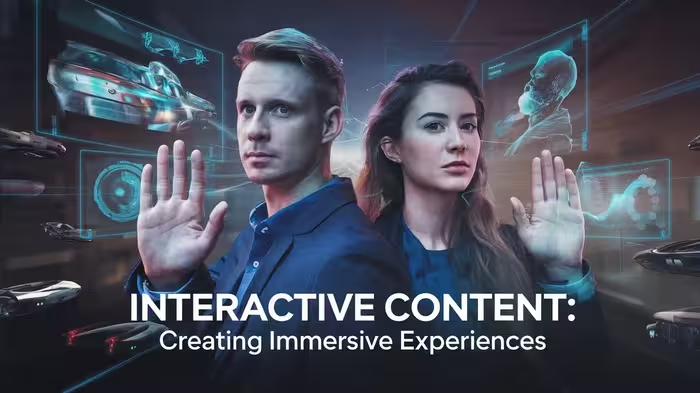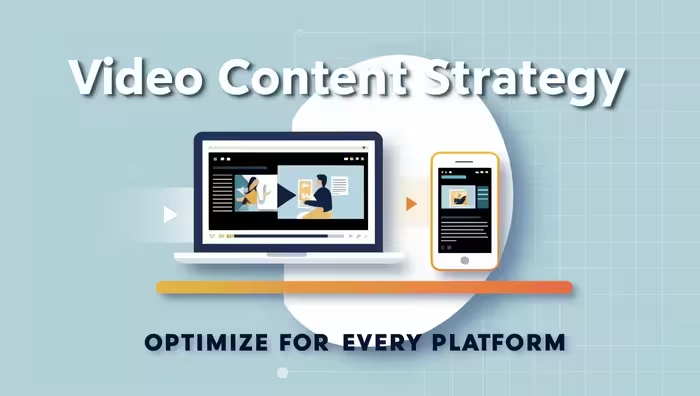In today’s digital landscape, capturing and maintaining audience attention is more challenging than ever. As content creators and marketers, we’re constantly seeking new ways to stand out from the crowd and deliver memorable experiences to our audiences.
Enter interactive content – a game-changer in the world of digital marketing and user engagement. This article will explore the exciting realm of interactive content and how it can help you create truly immersive experiences for your audience.
What is Interactive Content?
Interactive content is a type of digital media that requires active participation from the user, rather than passive consumption. It encourages users to engage with the content in meaningful ways, often through clicking, swiping, answering questions, or making choices.
This two-way interaction creates a more personalized and memorable experience for the user, leading to higher engagement rates and better information retention.
Unlike traditional static content, interactive content adapts and responds to user input, making each experience unique. This dynamic nature allows for a more tailored and engaging user journey, which can significantly impact how your audience perceives and interacts with your brand.
Types of Interactive Content
There are many different forms of interactive content, each with its own strengths and use cases. Let’s explore some of the most popular types:
Quizzes and Assessments
Quizzes and assessments are among the most widely used forms of interactive content. They can range from fun personality tests to serious skill evaluations. These tools are great for:
- Engaging users in a playful manner
- Gathering valuable data about your audience
- Providing personalized recommendations or results
- Educating users about a topic in an entertaining way
For example, a skincare brand might create a quiz that helps users determine their skin type and recommends suitable products based on their answers.
Calculators and Tools
Interactive calculators and tools provide practical value to users by helping them solve specific problems or make informed decisions. Some examples include:
- Mortgage calculators for real estate websites
- Calorie counters for fitness apps
- ROI calculators for B2B services
- Carbon footprint calculators for environmental organizations
These tools not only engage users but also position your brand as a helpful resource in your industry.
Interactive Infographics
Static infographics have been a content marketing staple for years, but interactive infographics take information visualization to the next level. They allow users to:
- Explore data points in more detail
- Customize the information displayed based on their interests
- Animate elements to better illustrate concepts or trends
An interactive infographic about global climate change, for instance, might allow users to see how different factors affect temperature rise over time.
360-Degree Videos and Virtual Tours
These immersive experiences transport users to different locations or environments, allowing them to explore at their own pace. They’re particularly useful for:
- Real estate companies showcasing properties
- Tourism boards promoting destinations
- Museums offering virtual exhibitions
- Businesses giving behind-the-scenes looks at their operations
By providing a more comprehensive view than static images or traditional videos, 360-degree content can significantly increase user engagement and time spent on your site.
Augmented Reality (AR) Experiences
AR technology overlays digital elements onto the real world, creating unique and memorable interactions. Some applications include:
- Virtual try-on experiences for fashion and cosmetics brands
- Interactive product demonstrations
- Educational experiences that bring textbook content to life
- Location-based AR games or scavenger hunts
As AR technology becomes more accessible, it opens up exciting new possibilities for creating truly immersive content experiences.
Benefits of Interactive Content
Incorporating interactive elements into your content strategy can yield numerous benefits for both your audience and your brand. Let’s explore some of the key advantages:
Increased Engagement
Interactive content naturally encourages users to spend more time with your brand. When people actively participate in an experience, they’re more likely to remain focused and interested. This increased engagement can lead to:
- Longer time spent on your website or app
- Higher click-through rates
- More social shares and word-of-mouth recommendations
- Improved brand recall and loyalty
For example, a well-designed quiz can keep users engaged for several minutes, compared to the few seconds they might spend skimming a traditional blog post.
Better Data Collection
One of the most valuable aspects of interactive content is its ability to gather rich, first-party data about your audience. As users interact with your content, they provide insights into their:
- Preferences and interests
- Pain points and challenges
- Decision-making processes
- Demographic information
This wealth of data can inform your marketing strategies, product development, and customer service efforts. Just remember to be transparent about data collection and comply with relevant privacy regulations.
Improved Learning and Retention
Interactive content is an excellent tool for education and training. When users actively engage with information, they’re more likely to remember it. This principle, known as active learning, can be applied to various contexts:
- Customer onboarding and product tutorials
- Employee training programs
- Educational content for students or lifelong learners
- Complex topic explanations for general audiences
For instance, an interactive simulation of a scientific concept can help students grasp difficult ideas more easily than a textbook explanation alone.
Enhanced Brand Awareness
Creating unique, high-quality interactive experiences can help your brand stand out in a crowded digital landscape. When done well, interactive content can:
- Showcase your brand’s creativity and innovation
- Demonstrate your expertise in your field
- Create shareable experiences that expand your reach
- Build a stronger emotional connection with your audience
A memorable interactive experience can leave a lasting impression on users, increasing the likelihood that they’ll remember and choose your brand in the future.
Creating Effective Interactive Content
Now that we’ve explored the benefits of interactive content, let’s dive into the process of creating effective experiences that resonate with your audience.
Define Your Goals
Before you start creating interactive content, it’s crucial to clearly define your objectives. Ask yourself:
- What do you want to achieve with this content?
- How does it fit into your overall marketing strategy?
- What actions do you want users to take after engaging with the content?
Having clear goals will guide your content creation process and help you measure success later on.
Know Your Audience
Understanding your target audience is key to creating interactive content that resonates. Consider:
- Their demographics and psychographics
- Their pain points and challenges
- Their preferred content formats and platforms
- Their level of technical expertise
This information will help you tailor your interactive experiences to meet your audience’s needs and preferences.
Choose the Right Format
Select an interactive format that aligns with your goals and audience preferences. For example:
- If you want to educate users about a complex topic, an interactive infographic might be ideal.
- If you’re looking to generate leads, a quiz or assessment could work well.
- If you want to showcase a physical product, a 360-degree video or AR experience might be the best choice.
Remember that you can combine multiple interactive elements to create a more comprehensive experience.
Design for User Experience
The success of your interactive content heavily depends on its user experience (UX) design. Keep these principles in mind:
- Make navigation intuitive and easy to understand
- Ensure fast loading times and smooth performance
- Use clear and concise instructions
- Incorporate visual elements that guide users through the experience
- Provide feedback and rewards for user actions
A well-designed user experience will keep your audience engaged and encourage them to complete the interactive journey.
Optimize for Mobile
With more people accessing content on mobile devices, it’s crucial to optimize your interactive experiences for smaller screens. This means:
- Using responsive design principles
- Simplifying navigation for touch interfaces
- Ensuring that interactive elements are easily clickable on small screens
- Testing your content across various devices and screen sizes
Mobile optimization will help you reach a wider audience and provide a consistent experience across all platforms.
Tools and Platforms for Creating Interactive Content
Creating interactive content doesn’t always require advanced technical skills. There are many tools and platforms available that can help you build engaging experiences:
- Articulate Storyline: Great for creating interactive e-learning content
- Ceros: A platform for designing interactive graphics and microsites
- Thinglink: Allows you to add interactive elements to images and videos
- Typeform: Ideal for creating engaging quizzes and surveys
- H5P: An open-source platform for creating various types of interactive content
When choosing a tool, consider factors like ease of use, customization options, integration capabilities, and pricing.
Measuring the Success of Interactive Content
To ensure your interactive content is meeting your goals, it’s important to track and analyze key metrics. Some important metrics to consider include:
- Engagement rate: How many users are interacting with your content?
- Completion rate: What percentage of users complete the entire interactive experience?
- Time spent: How long are users engaging with your content?
- Social shares: Is your content being shared across social platforms?
- Lead generation: How many leads are you capturing through your interactive content?
- Conversion rate: Are users taking desired actions after engaging with your content?
Use analytics tools to track these metrics and gather insights to refine your interactive content strategy over time.
Case Studies: Successful Interactive Content Campaigns
Let’s look at some real-world examples of brands that have successfully used interactive content to achieve their marketing goals:
- Buzzfeed Quizzes: Buzzfeed’s viral quizzes have become a cultural phenomenon, driving massive engagement and social sharing.
- Patagonia’s Footprint Chronicles: This interactive tool allows customers to explore the supply chain and environmental impact of Patagonia products, reinforcing the brand’s commitment to sustainability.
- New York Times’ “Snow Fall”: This Pulitzer Prize-winning interactive article set a new standard for immersive digital storytelling.
- IKEA’s AR App: IKEA’s augmented reality app allows users to visualize furniture in their own homes before making a purchase.
These examples showcase the diverse applications and potential impact of well-executed interactive content.
Future Trends in Interactive Content
As technology continues to evolve, so too will the possibilities for interactive content. Some emerging trends to watch include:
- Voice-activated interactive experiences
- AI-powered personalization of interactive content
- Increased use of virtual and augmented reality in marketing
- Interactive live streaming experiences
- Gamification elements in B2B marketing
Staying informed about these trends can help you stay ahead of the curve and continue creating cutting-edge interactive experiences.
Conclusion
Interactive content represents a powerful tool in the modern marketer’s arsenal. By creating immersive experiences that engage, educate, and delight your audience, you can stand out in a crowded digital landscape and forge stronger connections with your customers. As we’ve explored in this article, interactive content comes in many forms and offers numerous benefits, from increased engagement to better data collection.
The key to success lies in understanding your audience, setting clear goals, and designing user-friendly experiences that provide real value. With the right approach and tools, you can create interactive content that not only captures attention but also drives meaningful results for your brand.
As technology continues to advance, the possibilities for interactive content will only grow. By embracing this dynamic form of communication, you’ll be well-positioned to meet the evolving expectations of your audience and stay ahead in the digital marketing game.
FAQs
- Q: How much does it cost to create interactive content?
A: The cost of creating interactive content can vary widely depending on the complexity of the project, the tools used, and whether you’re creating it in-house or hiring external help. Simple quizzes or calculators can be created for free or at low cost using online tools, while more complex AR experiences or custom interactive videos may require a significant investment. - Q: Can interactive content improve my website’s SEO?
A: Yes, interactive content can positively impact your SEO in several ways. It can increase time on site, reduce bounce rates, and encourage social sharing – all factors that search engines consider when ranking websites. Additionally, unique and valuable interactive content can attract backlinks, further boosting your SEO efforts. - Q: How can I make my interactive content accessible to users with disabilities?
A: Ensuring accessibility is crucial for reaching all users. Some tips include providing alternative text for images, ensuring keyboard navigation is possible, using sufficient color contrast, and offering captions or transcripts for audio and video content. It’s also important to test your interactive content with assistive technologies. - Q: What’s the difference between interactive content and gamification?
A: While there’s some overlap, interactive content is a broader category that includes any content requiring active user participation. Gamification specifically refers to applying game-design elements (like points, leaderboards, or challenges) to non-game contexts. All gamified content is interactive, but not all interactive content is gamified. - Q: How often should I update my interactive content?
A: The frequency of updates depends on the nature of your content and how quickly the information changes. For evergreen topics, you might only need to update the design or functionality every few years. For content based on current data or trends, more frequent updates may be necessary to keep the information relevant and accurate. Regularly reviewing user feedback and performance metrics can help you determine when updates are needed.


